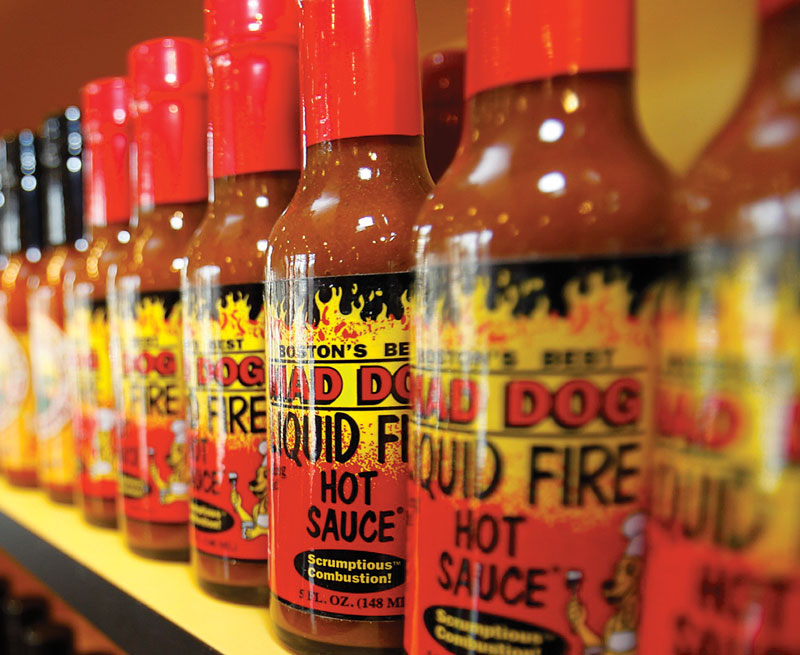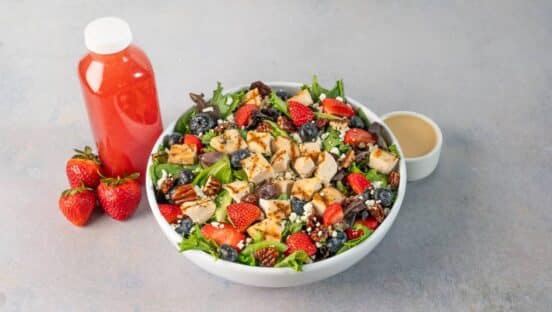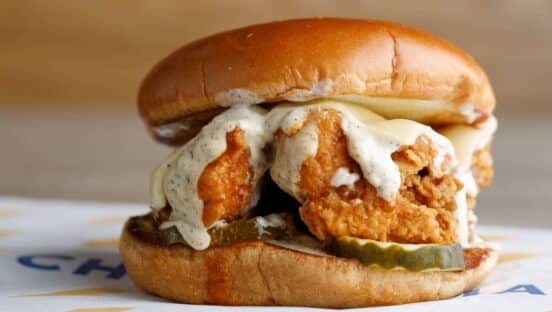Quick-serve and fast-casual restaurants are meeting today’s demand for variety head-on, but they’re not just doing it with menu diversification. Some are providing customers with greater selections in the condiments they offer, allowing guests to customize their own meal with expansive condiment bars.
And it’s not just a rote selection they’re offering, either; these are top-notch products, since it seems traditional line-ups of mustard, mayo, ketchup, and ranch dressing simply don’t, well, cut the mustard anymore.
Perhaps the ultimate in condiment choices is Rockville, Maryland–based California Tortilla, whose Wall of Flame with 75 hot sauces has attracted a cult following over the 17 years the chain has been open.
“People began coming to us because of our Wall of Flame,” says vice president of operations Keith Goldman. “It really has become one of our brand identifiers. And it really fits in well with our culinary focus because we have so many different flavors and we view the hot-sauce wall as the accent.”
The sauce selection at California Tortilla has grown over the years.
“As we added more and more sauces to the selection, people became more and more interested in the different flavors and varieties of hot sauces,” Goldman says. “To some it became one of the biggest reasons for frequenting California Tortilla; for others it was an introduction to flavors they had never experienced before.”
Customers came to expect that a comprehensive list of hot sauces would always be available “and that California Tortilla would carefully select the list the same way a sommelier would put together a great wine list for a restaurant,” he adds.
Companies just getting started with condiment innovation, however, don’t have that customer expectation and must craft their condiment programs with consumer demand in mind.
Customize, customize, customize
“People really want to customize their meal, and the hot sauce is a perfect vehicle to give that perfect accent of flavor that makes it so they can’t get that anywhere else,” Goldman explains.
Alkis Crassas, president of Tampa, Florida–based EVOS, also believes that the customization factor is most important when it comes to condiments.
“People like to customize more and more, so giving them the option to do so is our chance,” he says. “People are more sophisticated and aware of what their needs are—nutritionally and for quality.”
EVOS doesn’t quite have a Wall of Flame, but it does have a Ketchup Karma Bar. It features the chain’s four signature flavored ketchups: Original Americana, Cayenne Firewalker, Mesquite Magic, and Garlic Gravity.
“It’s taken us years to get to these four flavors,” Crassas explains, “and they are very equally consumed.” There have been other varieties, including a coriander ketchup that had a loyal following, “but not loyal enough,” Crassas says.
Diners have come to expect customization wherever they can get it, says Kathy Hayden, a foodservice analyst with Mintel.
“It’s diners in the driver’s seat,” she says. “They want an element of control, whether it’s calling ahead to make sure their food is ready when they want it or mixing and matching condiments.”
Doing things the customer’s way is the name of the game at Mooyah, too.
The 23-unit burger chain offers its own Mooyah Sauce (which bears some resemblance to Thousand Island dressing) on top of Heinz ketchup, Hellmann’s mayonnaise, French’s mustard, KC Masterpiece BBQ sauce, A1 sauce, Hidden Valley Ranch, Cholula sauce, and Frank’s Original buffalo sauce.
“One of the key tenets of our business is ‘a million ways to love your burger,’ so we need to have a variety of condiments,” says Michael Mabry, director of franchise and culinary for Mooyah. “Customers want customization. They want their burger their way.”
But along with variety, it’s also very important to Mooyah that all of its sauces, except its Mooyah Sauce, are brand names.
“They’re the highest quality, the most recognized,” Mabry says. “Brand names show quality and show we are listening to our guests. There’s a reason these brands are No. 1 sellers and that’s because that’s what the consumer wants.”
Quality is key
Condiment quality is a must across the board for operators.
Though that’s the case at California Tortilla, offering dozens of hot sauces was originally a joke, Goldman says. “But over the years we’ve found there were a lot of real, fanatical people out there who love hot sauce,” he says. “So I became more interested in it and we started to build a list of sauces that were quality and had good ingredients.”
Now the quality of the sauces is the focal point, Goldman says. “We started to pick the sauces we carry based on their ingredients. I want to see that the first ingredient is a pepper and that it has fresh lime or fresh cilantro in it. It used to be vinegar primarily, but I think people need more and more flavors.”
Having high-quality condiments is essential, Hayden says, because so many customers have traded down to quick-serve and fast-casual restaurants from casual dining in recent years.
“Once people trade down, they’re accustomed to something new and you can now keep them coming back,” she adds.
Aaron Noveshen, founder and president of The Culinary Edge, a consulting firm in San Francisco, also says that restaurants are upscaling their condiments.
Aïoli, for example, “is starting to pop up everywhere in the mainstream and is appearing in quick-serve restaurants,” he says. “It’s a way of upscaling mayonnaise and giving mayonnaise more cachet. But it’s hit the prime time.”
With so many companies expanding their menus and serving innovative foods, customers have come to expect high-quality everything, says Scott Redler, COO of Freddy’s Frozen Custard & Steakburgers. Redler says his Wichita, Kansas–based concept strives to meet those demands by stepping up its condiment quality.
[pagebreak]
“The basic condiments done right are what the guests expect,” he says. “They want a little fun and the variety to the basics.”
“It’s the details that make the difference,” adds Shane Schaibly, corporate chef for Tampa-based Front Burner Brands, which owns Burger 21. The condiments add something extra to meals, he says, which really makes them stand out.
“Condiments could and should differentiate a chain, particularly in a crowded market,” Hayden says. “Even a partnership with a valued name brand is another way to differentiate.”
This differentiation means that the most popular condiments vary from restaurant chain to restaurant chain.
The popular picks
At California Tortilla, the favorite hot sauces are those containing mango. These have some heat but tend toward the medium to mild end of the scale. After those, the most popular are the hotter sauces. “People are always feeling challenged to try the hottest they can,” Goldman says.
Hot is also popular at Freddy’s. Some guests want their food kicked up a notch, Redler says. “They want a more intense flavor. Lots of people order jalapeños and grilled jalapeños.”
Burger 21’s most popular condiment is honey mustard, but otherwise, the popularity of sauces depends on the age of the diner, Schaibly says. Kids gravitate toward the chain’s toasted marshmallow syrup (especially good with shoestring sweet potato fries, Schaibly says) and the apple cider sauce.
Consumers are more adventurous now, he explains. “They don’t necessarily want an entire burger with this crazy sauce, but they will have a little taste of each sauce. Some people try all of them. But regulars know and go back for their favorite. They can have it added at the back-of-house if they know they love something. It takes away a step, and we find that most people actually want to add to their own meal a bit.”
Noveshen sees old-school sauces, such as Russian dressing and green goddess dressing, getting more popular.
“There’s still continued acceptance for these retro classics, but made with real ingredients,” he says. “It’s what Millennials want. It’s part of the transparency movement. It’s the simple, pure, and real. A lot of it’s about a connection—to a source, to an emotional tie, to history, or something that is real. Things are moving so quickly that the backlash is that people don’t have enough of those connections, so they seek them out.”
No matter the condiments operators serve, the experts say it’s important to keep the selection vibrant.
Every year Goldman switches out 10–12 of California Tortilla’s sauces. There are always complaints, he says, but alternatives are suggested to customers who complain, and that usually satisfies them.
Burger 21 also changes up its sauces from time to time. On top of ketchup, mustard, honey mustard, toasted marshmallow, and apple cider, the company offers Thai ketchup, chipotle mayo, and Ragin’ Cajun.
“It’s cool because they’re not on the menu anywhere, so we have a little freedom so we can turn on a dime and change the sauce and can put something crazy on there,” Schaibly says.
“We don’t necessarily change because a sauce isn’t working, but to change it up. And the guests love it; it’s fun. People become very passionate about their sauce and are in love with their sauce. They sometimes mix and match with half a pump of one and half a pump of another.”
The sweet spot
But what’s the saucy sweet spot when it comes to how many condiments to carry?
For California Tortilla, it’s 75. “I could have kept going, but it’s a significant investment in inventory, so you have to order enough of every sauce to keep it on your shelf and have a backup,” Goldman says. “We order two to three cases of each flavor at any time. So I drew the line at 75.”
Having learned the hard way, however, Goldman does tend to stick with hot sauces that come from just a dozen or so manufacturers.
“In the past I’d get mom and pops coming to me, and I’d give [their products] a try. But sometimes they go out of business and you have a hole on your list. And sometimes you can’t get some sauces because of problems in countries, like Costa Rica, for example.”
Burger 21’s Schaibly says it’s possible for condiment line-ups to get overwhelming. “In our restaurants, it’s more about the flavors and how you can combine them,” he says. “I think the sweet spot is 10.”
Moe’s Southwest Grill landed on five salsas “in order to provide a variety of heat level, flavor profiles, and ingredients,” says corporate chef Dan Barash. The chain offers five salsas, two of which rotate out every four to six months. They include pico de gallo, roasted corn pico de gallo, sour cream, jalapeño lime sour cream, cilantro bacon sour cream, guacamole, and queso.
“Knowing how much guest preferences vary and how much people appreciate customization, the more the merrier,” Barash says.
Moe's Raises the Bar
Moe's Southwest Grill let its guests participate in its condiment development with a contest that ran this summer.
Raise the Salsa Bar Contest launched May 24 on Facebook.
Guests were encouraged to submit their best original salsa recipe for a chance to have it featured alongside Moe's famous fresh-made salsas in the chain's salsa bars.
"Moe's fans know we offer free chips and a variety of salsas from our salsa bar with every meal," says spokeswoman Lauren Barash. "But many don't know that we have these rotating seasonal salsas that are made fresh daily and all of our salsas are made from all-natural ingredients. We're using this contest to get the word out about that in a fun and engaging way."
Voting for the contest was completed through Facebook and finalists will be tasted in different markets.
"The contest gives guests yet another way to express their creativity and customize their meal," says corporate chef Dan Barash.











